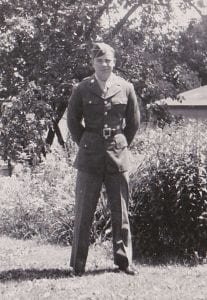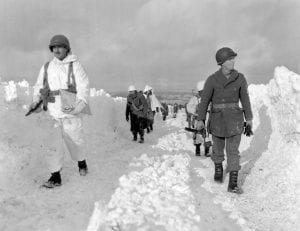An empty foxhole, an anonymous grave, and a World War II mystery solved after 74 years

Jack Cummings posed on the lawn in his uniform, hands clasped behind his back, his Army cap perched on his head at a jaunty angle.
His father, Leo, or his mother, Helen, had probably said, “Stand over there, Jack, while I take a picture.”
John B. “Jack” Cummings was 22, a handsome college man headed off to World War II from Juneau, Wisc., where his family, no doubt, prayed he would return.
But on Dec. 31, 1944, near the French village of Neuhaeusel on the Rhine River, he vanished from his foxhole, leaving behind a bloody piece of his skull and a helmet with a bullet hole in it.
For the next 74 years — until this summer — he was missing in action, his body declared non-recoverable. He existed largely in old military files filled with dental charts, plaintive letters from his mother, and typed reports about the Army’s futile attempts to account for him.
“Complete negative findings,” a 1947 Army report stated.
But a year earlier, the solitary grave of a slain GI had been discovered across the Rhine River in the German town of Iffezheim.
He had been killed near Neuhaeusel by an enemy raiding party that had attacked across the river. His body had been brought back over the Rhine and buried under a wooden cross that read “Hier Ruht ein U.S.A. — Soldat gef. am 31.12.1944”: “Here rests a U.S.A. soldier,” who fell on Dec. 31, 1944.
For seven decades, as his parents mourned, aged, and then passed away, and his sister, Mary Ellen, married and had 12 children, no one knew that the anonymous “U.S.A.-Soldat” was John B. Cummings.
Last month, after using state-of-the-art computer data and mapping programs, and DNA comparisons, the Defense Department announced that it had identified Cummings in July and that he had been quietly buried with honors on Oct. 13, beside his parents in Hazelhurst, Wis.

Cummings had been one of 72,797 Americans unaccounted for from World War II, according to the Arlington-based Defense POW/MIA Accounting Agency (DPAA).
His case illustrates how one GI could disappear in the chaos following the gigantic war, and how technology and a dogged government historian found him.
In the beginning, even the date of Cummings’s death was not clear.
The Army listed it as Jan. 4, 1945. But the Germans who had buried him, and knew firsthand, had put it at Dec. 31, 1944.
On that date the German army launched Operation North Wind, often called the second Battle of the Bulge, in which massed enemy forces surged across the Rhine River to attack the relatively green and under-strength U.S. Seventh Army, of which Cummings was a member.
Before it ended in American victory, thousands of GIs had been killed and wounded or had just disappeared.
Cummings and other men of Company A, of the 276th Infantry Regiment, had reached the banks of the Rhine River on Dec. 29, 1944, according to a memoir by Frank H. Lowry, an A company veteran. They were strung out in foxholes along the river and told to keep an eye on the Germans on the opposite bank.
They were also told to get rid of any letters and remove their unit patches to deny information to the enemy should they be captured. This would bedevil identification efforts later.
On that frigid New Year’s Eve, Cummings, armed with a Browning automatic rifle, was stationed alone about 10 yards from the river bank. Two members of his squad reported that he was okay when they saw him that night. Later, gunfire was heard, and when his buddies made their way back, he was gone.
“Only his helmet was found nearby with a bullet hole through it,” an Army report stated. “A blood-stained piece of his skull bone was also found, but his weapons and equipment were missing. … A path was found which indicated that his body was dragged to the river. … It can be presumed that … Cummings was killed by the enemy and his body thrown into the Rhine River.”
“Further search for the remains of this soldier would be futile,” the report states.
His parents had received a telegram on Jan. 23 saying that Cummings was missing in action. “If further details or other information are received you will be promptly notified,” it said.
Many months passed with no word.
In 1947, his mother wrote the Army, wondering whether the service might help her offer a reward in Germany for information about John. “I would gladly furnish the reward,” she wrote. The Army said it couldn’t help.
Meanwhile, in 1946, across the Rhine River, a soldier scouting for the American Graves Registration Command was told by the mayor of Iffezheim that a GI was buried nearby.
The graves registration soldier went to the site, which was just behind a German pillbox, about 30 yards from the river. He also interviewed a local German soldier who had helped bury the dead American that night.
The body, almost a complete skeleton, was exhumed on May 10, 1946. There were only remnants of clothing, according to Army records, and no dog tag. With no identifying information, the body was designated X-6454 and reburied with thousands of other U.S. soldiers in what is now the Lorraine American cemetery in Saint-Avold, France.
The years went by. Cummings’s father died in 1963. His mother passed away in 1972. The family seldom discussed John, according to his nephew, Mark Hartzheim, of Minocqua, Wis.
“They just never talked about this much,” he said in a telephone interview on Oct. 23. “That was typical I think of people from that generation. They compartmentalized things and internalized them and didn’t dwell on them. … But I’m sure it haunted them and troubled them the rest of their lives.”
Several years ago, Hartzheim became curious about the fate of “Uncle Jack.”
